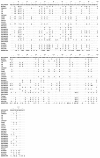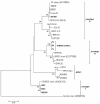Isolation and characterization of bovine parainfluenza virus type 3 from water buffaloes (Bubalus bubalis) in Argentina
- PMID: 22716217
- PMCID: PMC3430567
- DOI: 10.1186/1746-6148-8-83
Isolation and characterization of bovine parainfluenza virus type 3 from water buffaloes (Bubalus bubalis) in Argentina
Abstract
Background: Parainfluenza virus type 3 (PIV3) was isolated from dairy buffaloes (Bubalus bubalis) naturally affected with respiratory and reproductive clinical conditions.
Results: Examination of nasal and vaginal swabs collected from 12 diseased buffaloes led to the isolation of three paramyxovirus isolates from two animals. Antigenic, morphological and biological characteristics of these three isolates were essentially similar to those of members of the Paramyxoviridae family. Antigenic analysis by direct immunofluorescence and cross neutralization test placed these isolates together with bovine parainfluenza virus type 3 (BPIV3). Nucleotide and amino acid phylogenetic analysis of partial matrix gene sequences of the buffalo isolates and six field BPIV3 isolates from bovines in Argentina were studied. Buffalo isolates were similar to genotype B (BPIV3b) while the six BPIV3 isolates were similar to genotypes A (BPIV3a) and C (BPIV3c).
Conclusions: This is the first characterization of BPIV3 in water buffalo.According to the samples analyzed, in Argentina, the genotype B was found in buffalo and the genotypes A and C were found in cattle.
Figures



References
-
- Wang LF, Collins PL, Fouchier RAM, Kurath G, Lamb RA, Randall RE, Rima BK. In: Virus taxonomy: Ninth report of the international committee on taxonomy of viruses. King AMQ, Lefkowitz E, Adams MJ, editor. Elsevier Academic Press, San Diego, California; 2011. family Paramyxoviridae; pp. 672–685.
-
- Turner RB, Couch RB. In: Fields Virology. 5th edition. Knipe DM, Howley PM, editor. Lippincott, Williams & Wilkins, Philadelphia; 2007. Rhinoviruses : Parainfluenza Viruses : the viruses and their replication; pp. 1449–1496.
-
- Haanes EJ, Guimond P, Wardley R. The bovine parainfluenza virus type-3 (BPIV-3) hemagglutinin/neuraminidase glycoprotein expressed in baculovirus protects calves against experimental BPIV-3 challenge. Vaccine. 1997;15(6–7):730–738. - PubMed
Publication types
MeSH terms
Substances
Associated data
- Actions
- Actions
- Actions
- Actions
- Actions
- Actions
- Actions
- Actions
- Actions
- Actions
- Actions
- Actions
- Actions
- Actions
- Actions
- Actions
- Actions
- Actions
- Actions
LinkOut - more resources
Full Text Sources

